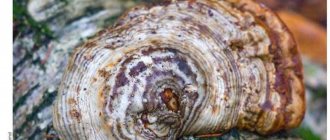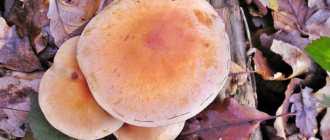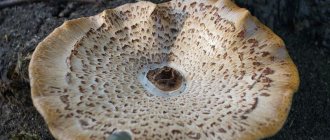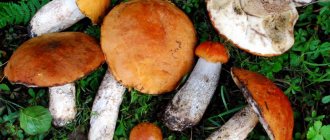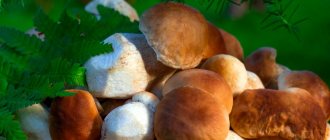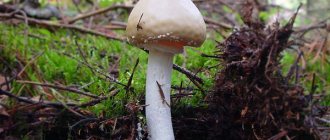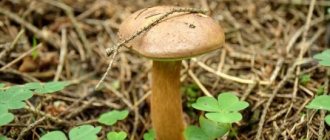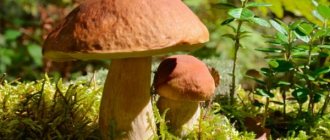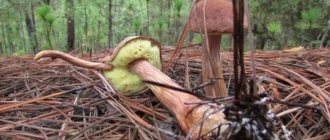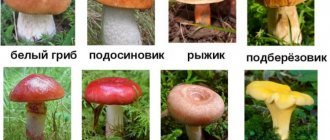Mushrooms
0
1840
Article rating
Kira Stoletova
The birch tinder fungus, which parasitizes deciduous trees, rarely becomes a victim of the mushroom picker itself. Little is known about this species, although its medicinal capabilities are significant. There is still controversy about the edibility of its fruiting bodies and ways to remove the bitterness.
Medicinal properties of birch polypore
Description
Birch tinder fungus, according to various sources, is an edible or inedible mushroom - the opinions of experts on this issue differ significantly. Its inedibility is supported by its bitter taste, which is less pronounced in young individuals. They are offered to be eaten.
The species is considered a prime example of a parasitic organism. The tinder fungus on the birch gradually destroys the tree. The mycelium affects only dry or rotten, i.e. diseased, and therefore weakened specimens, and performs a cleansing function in the forest.
Birch is the only tree on which this species parasitizes.
The birch tinder fungus looks like this:
- the stalk characteristic of cap-legged mushrooms is missing;
- fruiting bodies are annual;
- in young specimens the fruiting body is egg-shaped, in adults it is flat, hoof-shaped, reaching 25 cm in diameter and up to 5 cm in thickness;
- the surface color of the mushroom is white or cream, covered with a film; with age it becomes brown or brown, hard;
- hymenophore – tubular;
- The pulp is white, with a strong characteristic mushroom smell and sour taste.
The species is distributed throughout Russia. Often lives in places with high levels of humidity.
Irina Selyutina (Biologist):
Back in 1967, a book by the Czech scientist V. Ripacek, “Biology of Wood-Destructive Fungi,” was published in Moscow, in which he described the birch polypore species as parasitic, settling on weakened trees. According to currently known data, this species is classified as an active wood destroyer, causing intensively developing yellowish-brown or reddish-brown rot of a destructive type. As a result, the wood very quickly becomes rotten.
The attitude towards the mushroom is ambiguous. Mycologists refer to its inedibility and parasitic nature, and people use its fruiting bodies as a means of traditional medicine. The pulp is not dangerous to humans, but is unsuitable for food due to its irreducible bitterness.
Mushrooms that grow in the yard.
Mushrooms grow in the yard
Mushrooms grow in the yard
More than three years ago, my husband and I bought a dacha and planted the area in front of the house with grass. Everything was fine until this year, after another rain, toadstool mushrooms appeared on the lawn, and I have no idea what to do with them. As soon as it rains or my husband waters the lawn, white caps appear. What should I do?
Every gardener wants to have a well-groomed and beautiful lawn on his property, but sometimes this dream is spoiled by toadstools on the lawn. The appearance of mushrooms on the lawn is caused by either too damp soil or excessively acidic soil. At the same time, the quality of the soil in which mushrooms grow is always at its best, since mushrooms do not take root in an unhealthy or less favorable environment. This would be fine, but when mushrooms grow, they secrete substances, the excess of which affects the soil and causes bald spots on the lawn. Fungi reproduce by spores that travel through the air and, when they land on the soil, infect it, causing areas to darken. These areas are then overgrown with mushrooms. If you clean the soil in time, there will be no problems with the appearance of mushrooms.
There are the simplest and most affordable methods for caring for a lawn that is affected by fungi:
- Reduce the amount of watering to avoid excess soil moisture. Excessive shade on the lawn can also cause dampness, so take the trouble to thin out trees or bushes that may be causing the shade.
- Remove mushrooms manually, very carefully, so as not to provoke the spread of fungal spores. This can be done with a small knife; you need to hold the mushrooms, cut them and put them in a bucket or other deep container.
- Keep your lawn clear of leaves and other biodegradable debris, which provides a favorable environment for fungal growth. Fallen leaves not only spoil the aesthetic appearance of the lawn, but also have a positive effect on the growth of mycelium. To do this, use a rake or any other tool.
- Be sure to get rid of old stumps, where toadstools often appear. There are many methods for getting rid of stumps and old roots, ranging from chemical to mechanical.
- In the fall, sprinkle the lawn with sand. In this case, choose sand of the smallest grain size.
In addition to the above methods, there are a number of more complex procedures for getting rid of mushrooms on the lawn:
- Soil aeration. This procedure is carried out in several ways. For manual work in the garden, a special rake for aeration is sufficient, but if your lawn occupies a large area, then for greater efficiency it is worth purchasing an electric or gasoline aerator. This procedure must be carried out after every third mowing of the lawn. During the aeration process, immerse the teeth no more than ten centimeters. Scarification should be done at the beginning and end of the season (spring, autumn).
- Application of fertilizers. Treat the soil with organic fertilizers and antiseptics, which will greatly help in caring for the soil. The most suitable solution for the fertilization process will be a solution of copper sulfate: dilute 20 grams of powder in 10 liters of water. Spray your lawn with this mixture once a month maximum.
Important! Remember that removing fungi with aggressive chemicals will damage the lawn grass and reduce the quality of the soil. This may affect future care.
In addition, many experts in the field of agriculture advise getting rid of the top ten centimeters of soil, which will help get rid of the mycelium, which is the breeding ground for all the mushrooms on your lawn. Keep in mind that after such a procedure you will have to renew the grass sowing, but you should not rely on this method, since the mycelium can grow 50 centimeters or more into the soil.
Similar species
The birch tinder fungus has species similar in biology:
- fox tinder;
- the tinder fungus is real;
- false tinder fungus.
The fox polypore has a smaller size and a reddish color (externally and internally) in comparison with the birch polypore, which in addition is also distinguished by the folded shape of the fruiting body. It is thicker and hoof-shaped. The false polypore has a reddish-brown fruiting body, the flesh inside it is brown. The fruiting bodies of the false polypore species are perennial, they are very firmly attached to the surface of the tree trunk. The real tinder fungus, like the false tinder fungus, has a perennial fruiting body, but unlike it, it is characterized by the presence of a stalk, with which it is attached to the tree. Its flesh resembles a cork.
Birch tinder fungus is often confused with chaga. Chaga is a separate species of the kingdom Mushrooms, a sterile form of the beveled tinder fungus. Its fruiting body looks crumpled in appearance and resembles a black growth. It also parasitizes birch, the nomenclature name is Inonotus oblique or black birch mushroom.
Why is it dangerous for birches?
The tinder fungus loves to grow on injured areas of birch trees - this is the best place for its spores to penetrate. As the fungus grows, it leads to the development of rot. The affected trunk quickly collapses, the tree dries out and dies.
If you notice such a growth in your garden, you need to cut it off, and carefully clean the growing area with a knife and treat it with copper sulfate. This will help completely destroy the mycelium.
The procedure is carried out twice with an interval of 10 days.
Contraindications
Be sure to consult a specialist
Contraindications for external use are the presence of allergies or individual intolerance to the components of mushroom-based preparations. Folk recipes using birch polypore are not recommended for testing on children, the elderly, pregnant women and people with chronic diseases of the skin and joints.
Before using tinctures internally, consultation with a specialist is required.
Where and when are boletus harvested?
Mushrooms have chosen deciduous forests in the temperate climate zone and choose clearings for mycelium next to birch trees, with which they form mycorrhizae.
Young mushrooms are strong and tight to palpation. They choose open places for growth on the edges, clearings and along paths. The boletus does not like acidified soils near peat bogs; it chooses soil in low-lying forests with a neutral or calcareous substrate. People collect mushrooms from May until the autumn cold and first frosts. One of the subspecies - the marsh boletus - settles on peat bogs near swamps.
Multi-colored boletuses grow in small families or one at a time. Their colorful caps attract mushroom pickers from late June to early October. Mushrooms are cut under birch and poplar trees. Myceliums take root in mossy and gloomy forests, but in open areas under the rays of the sun.
A rare species, the pink boletus settles on peat bogs along the borders of swamps near birch and mixed forests, where it forms mycorrhiza with birch. Mushroom pickers collect mushrooms wherever there are birch plantings, right down to the tundra from the end of July to the end of September.
Gray boletus, also known as hornbeam, produces a rich harvest on the edges and clearings among:
- poplars and birches;
- hazel trees;
- hornbeams and beech trees.
Harvesting:
- when the rowan tree blooms;
- in July after haymaking;
- from late August to October.
Mushroom pickers sometimes find the stiff boletus (rare) in deciduous and deciduous-coniferous plantings near white poplars and aspens. The fungus prefers limestones, where it lives alone or in small families. The rare harvest is harvested from late June to mid-autumn.
In damp lowlands among birches, in pine-birch mixed forests, on the outskirts of clearings and among swamps, from mid-summer until golden autumn, people collect black boletus.
Application
The use of birch tinder fungus in everyday life is widespread. Its medicinal properties formed the basis of traditional medicine recipes.
Cooking
Birch polypores do not have wide culinary uses. But some mushroom pickers suggest eating young spring specimens. There is less bitterness in them, but it only intensifies with heat treatment. The taste of the fruiting bodies is low, so there is no point in cooking it.
Medicine
The medicinal properties of this species were discovered in ancient times. The keratinized skin was removed using whole fruiting bodies and disinfected.
Beneficial substances contained in the pulp help with weight loss:
- weaken appetite;
- have a diuretic effect;
- treat constipation and cleanse the intestines.
A general stimulating effect on the body is also noted. During the cold season, tincture of birch polypore will strengthen the immune system, improve overall mood and emotional background.
Medicinal tinctures and rubs from birch polypore are used for joint diseases and wound treatment. The pulp contains natural anti-inflammatory substances. Fruiting bodies cut into strips are used as a bandage for small open wounds.
In medicine, the following is obtained from the fruiting body:
- Polysaccharides that serve as the basis for experimental drugs in the treatment of oncological problems.
- An extract (or extract) that has an anti-inflammatory effect and works as a pain reliever.
- Chitin and pectin, used to make colon cleansers and dietary supplements.
- Polyporenic acid isolated from fruiting bodies in the laboratory. It is part of medications against ulcers and inflammation of the gastrointestinal tract.
- Some biologically active substances that are beneficial for the functioning of the liver and kidneys help cope with infiltrates.
- Powder made from ground pulp. It is a good antiseptic for wounds and promotes healing.
All preparations and tinctures are obtained only from safe polypores on birch. The false polypore species is not used for medicinal purposes. Specimens collected in environmentally unfavorable places are also not used.
To prepare the infusion, 1 part of the raw material is infused in warm water, then passed through a meat grinder and infused again in a dark place. At this stage, the ratio of warm water and raw materials is 1:5.
The powder is used after treating the wound with peroxide or alcohol, sprinkling it under a sterile bandage. Based on the powder or dried fruit body, an alcohol tincture is prepared for rubbing joints. 5 g is infused in 150 ml of vodka or alcohol for 14 days. The same tincture is diluted with honey and taken orally in 5 ml doses to strengthen the immune system. The course of treatment lasts 3 weeks.
How to identify false boletus
In conclusion, let’s consider an important question for a novice mushroom picker: how to distinguish a real boletus from its double?
To avoid mistakes, you should remember a few simple rules. Firstly, boletus flowers do not like light. If you see a similar mushroom growing in an open place, this is already a reason for doubt.Secondly, false boletus usually tastes bitter, so worms do not eat them. Examine the mushroom. If it is perfectly clean, with veins on the legs in the form of blood vessels, then most likely you are holding an inedible mushroom in your hands.
Thirdly, a proven way to determine whether it is a real boletus or not is to break the cap. Here the false mushroom will immediately give itself away, starting to noticeably turn blue. And if after this action the flesh has practically not changed, feel free to put the mushroom in the basket.
